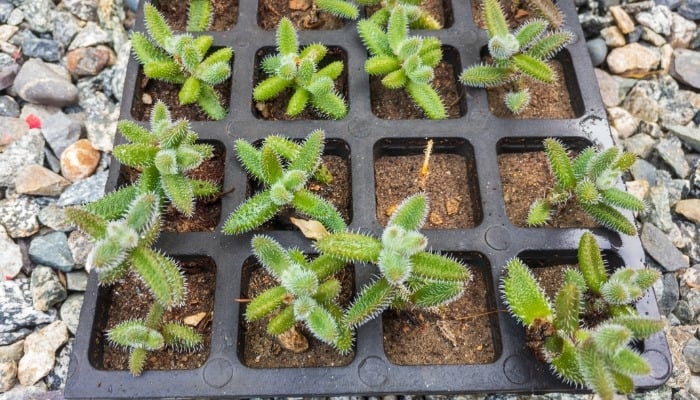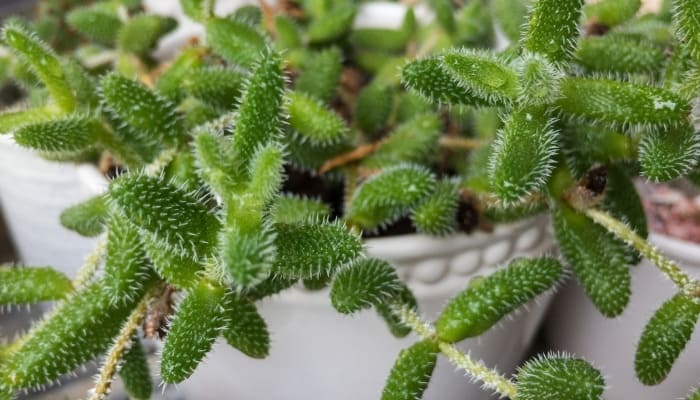If you encounter any issues while attempting to rephrase the following text, please respond with the error message: Unable to process the request due to encountered difficulties.
The pickle plant, scientifically called Delosperma echinatum, is a tiny, bushy, blooming decorative plant found in the deserts and beaches of South Africa.
The pickle plant gets its name from the shape of the leaves, which look like little pickles.
It’s a succulent plant with an evergreen appearance, and its small size makes it perfect for small containers, hanging baskets, and indoor decoration.
Caring for the pickle plant is a simple process if you give them the right conditions.
You can grow the pickle plant anywhere globally, but it can start changing color and dying without proper care.
Why is my pickle plant dying? A pickle plant can begin to die due to several reasons including, but not limited to, overwatering, insufficient or too much light, extreme temperature changes, underwatering, lack of nutrients, waterlogged soil, oversupply of nutrients, root rot, pests, and diseases.
Read on to explore 11 possible problems and corrective steps you can take to save your dying pickle plant.
11 Causes for Pickle Plant Dying & Solutions
There are a few things you may be overdoing or not doing right that can lead to the demise of your favorite succulent plant, especially if it’s your first time growing the pickle plant.
These include:
1. Overwatering
Overwatering is a common issue for pickle plant growers and gardeners. The pickle plant is a succulent that stores water in the leaves and stem.
Giving too much will only cause the leaves and tissues to bloat and eventually burst.
Solution
A mature plant only needs water when the soil gets dry. Always check the soil for moisture. If the upper layer of the soil has moisture, don’t water the plant.
A 5-to-7-day watering gap is enough to achieve a balanced water supply.
2. Insufficient Light
The pickle plant does well under the full sun with some partial shade. It can quickly start deteriorating with insufficient light.
Not exposing your plant to enough sunlight can cause slow growth and death of the leaves and flowers.
Solution
A constant supply of light can help your pickle plant recover.
You can take it outside in the full sun or partial shade, or ensure you place it somewhere bright if you’re growing it indoors, like next to the window.
3. Too Much Direct Sunlight
Succulents glow better with an excellent color tome when exposed to the right amount of sun, but you have to be careful not to overdo it.
The leaves of your pickle plant can burn or have faint white patches if you expose it to too much direct sunlight.
Solution
Watch out for an unusually yellow tone forming on the edge of the leaves, and move your plant to an environment that’s a bit cooler with plenty of indirect sunlight.
4. Extreme Temperature Changes
The pickle plant needs a slightly warm environment to grow and may start dying in extreme temperature changes like snowfalls and frost or heat waves.
Solution
Protect your plant from snowfall and hard frost if you grow it in cold regions. You can keep it indoors during extreme winter or in a greenhouse with a controlled temperature.
If you’re in a scorching area, you can take it indoors to protect it from harmful sunlight and extreme temperatures.
5. Underwatering
Although the pickle plant can store water and tolerate drought conditions, you don’t want to neglect it for too long, especially during the summer.
Underwatering can cause dry leaves, and as the moisture inside the plant reduces, there will be wrinkles on the skin.
Solution
Always check the plant for watering needs. Smaller pickle plants need frequent watering because they can’t store water for their survival.
You also need to water more frequently during the summer than in winter. Increase the amount of water every time you water the pickle plant to promote faster growth.
6. Lack of Nutrients
As the plant grows, it can consume all the nutrients in the soil and create a nutrient deficiency.
Without the nutrients, the growth rate decreases, the leaves and flowers change color, and the plant can die.
Solution
To prevent your pickle plant from dying due to a lack of nutrients, consider adding fertilizer to enhance its health and physique.
Mix the fertilizer with water and feed it to your plant while watering every month. I recommend a gentle fertilizer designed for succulents, like this liquid food from Cute Farms.
7. Waterlogged Soil
Waterlogged soil will cause your pickle plant to sit in wet conditions more than it should, causing it to rot.
The leaves may turn black from the bottom, and the stems will look mushy. The soil can get waterlogged because of overwatering, poor quality, and the pot.
Solution
Use cactus or succulent soil mix (find it here) added to some perlite to promote better aeration and drainage.
You can also use a larger pot, add two inches of gravel, and place the plant on the gravel before adding potting mix so that the roots don’t sit in excess water every time you water it.
8. Too Much Fertilizer
Too much fertilizer can damage or burn the leaves of your pickle plant and cause leggy growth where some parts of the roots and stem elongate disproportionately.
Overfertilization can also cause stunted growth, wilting, and collapse of the plant.
Solution
Only fertilize your pickle plant during periods of active growth. Decrease the frequency and amount of fertilizer once growth slows down during the winter or fall seasons.
Try using manure tea to enrich the soil instead of synthetic fertilizer since it’s too mild to burn your pickle plant.
9. Root Rot
Root rot is common if your pickle plant is overwatered and the soil is not draining well or if it sits in too dark environments with prolonged soil moisture.
You may see rapidly yellowing leaves, a rotten brown base, and shriveled growth.
Solution
Dig the pickle plant out of the soil, and cut off any black or brown roots that are already rotten.
Let the roots air dry by placing them on a mesh screen or other filter for a few days. Replant when the roots are dry.
10. Pests
Mealybugs, aphids, spider mites, and fungus gnats can invade the pickle plant on rare occasions. You may notice waxy or whitish substances on the leaves and stems.
Solution
Use natural repellent remedies like neem oil (I always see good results with this organic neem) to weed out pests.
Another treatment is to dip a cotton swab in alcohol and wipe off affected areas to suppress infestations without causing any damage.
11. Disease
The pickle plant is very resistant to diseases but can be affected by root rot, rust, powdery mildew, or fungal infections caused by too much water.
Solution
Organic fungicides like neem oil or horticultural soap can come in handy to eradicate diseases.
Spay all around the plant, and emphasize the hard-hit areas. Do this weekly for over a month, regularly inspecting for effectiveness.
Pickle Plant Propagation

One of the fastest ways to propagate a pickle plant is through stem cuttings. Follow these steps to multiply the number of pickle plants in your garden or indoor space:
- Cut a few stems from unblemished parts of the mother plant during spring or fall.
- Leave the cuttings outside so the wounds heal off completely.
- Prepare well-draining potting soil, or purchase it from the local store.
- Moisten the top soil gently and replant the cuttings. Avoid too much water to prevent the development and breeding of bacteria.
- Place the pot somewhere with zero freezing conditions. The plant needs a bright and warm environment to grow. Within a few weeks, root hairs will develop.
Seedlings can also help propagate the pickle plant, but it will take longer to see tangible results.
Pickle Plant Tips for Success
The pencil-like stems of the pickle plant tend to bend downward as they grow taller, and if it’s indoors in a pot, the plant can lose its vigor.
Ensure you place the plant where it gets enough sunlight so that it grows toward the direction of the light.
Prune any leggy stems you spot during early spring when growth hormones are more responsive and the plant is recouping the strength needed to stimulate essential enzymes.
Get rid of dead flowers after the blooming season for a radiant appearance. With proper soil, watering, and sunlight, your pickle plant won’t need much maintenance.
Related Questions:
How Often Should You Water a Pickle Plant?
A watering gap of 5 to 7 days is enough to maintain a balanced water supply for mature pickle plants. Smaller plants can’t store water, so they need more frequent watering.
Check the upper soil layer for moisture, and let the soil dry out before watering again.
How Big Does a Pickle Plant Get?
Pickle plants have a shrub-like appearance, and the leaves can reach 18 to 20 inches in height with the stems reaching 1 inch in width.
Conclusion
If your pickle plant is dying, try changing the water, temperature, light, and soil conditions.
Also, watch out for pests and diseases, and feed the plant with sufficient fertilizer to ensure it gets enough nutrients.
You can also propagate the plant if it can’t recover or you simply want to increase the number of plants. It’s low maintenance, so you don’t have to worry if you’re always short on time.

